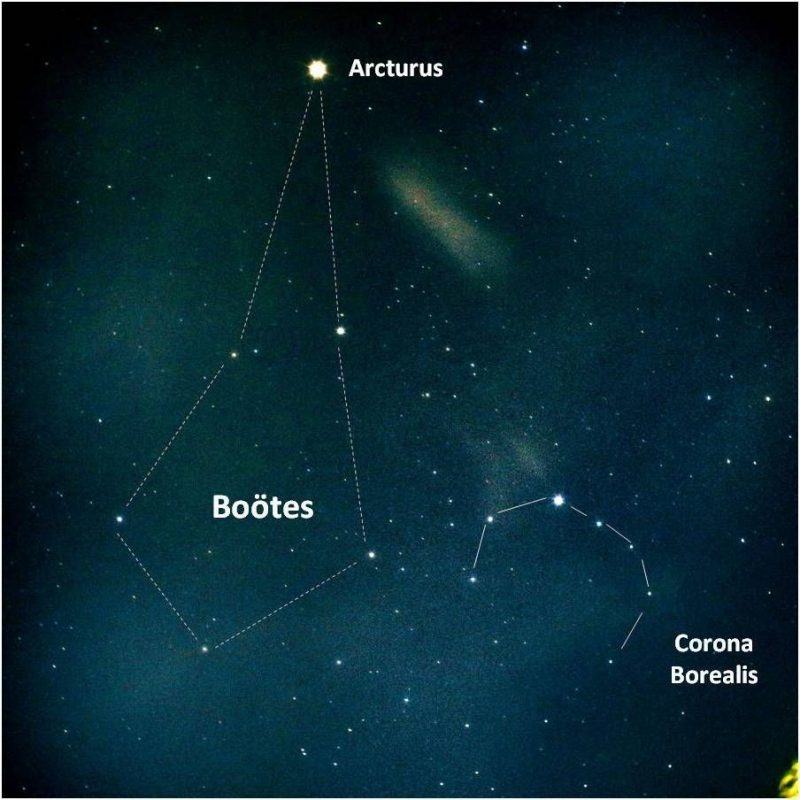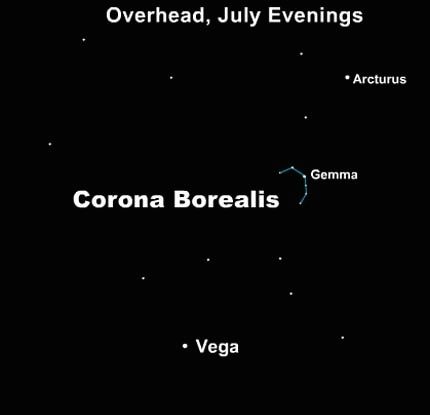
Look for Corona Borealis between 2 bright stars
In the evening in July, look for the constellation Corona Borealis, also known as the Northern Crown. You’ll need a dark sky to see it. But, if you have one, the constellation is easy and distinctive. It makes the shape of the letter C. In the middle of the C is a white jewel of a star. This star, the brightest light in the Northern Crown, is called Alphecca or Gemma.
To see this famous C-shaped assemblage of stars from the Northern Hemisphere, you’ll be looking high overhead during the evening hours in July. From the Southern Hemisphere, the constellation is low in the northern sky.
The Crown is located more or less along a line between two bright stars. The first is the orange star Arcturus in the constellation Boötes the Herdsman, shown in the photo at top. The second is beautiful, blue-white Vega in the constellation Lyra the Harp.
Arcturus has already passed its highest point in the evening at this time of year and is slowly descending to the west. Vega is still high in the east on July evenings. With dark skies you will notice the orange color of Arcturus, and Vega’s bright blue-white tinge.
Corona Borealis can be found between these two stars, though closer to Vega. Remember, a dark sky is best for seeing this faint semicircle of stars.

Gem of the Northern Crown
The brightest star in Corona Borealis is Gemma. The meaning of this Latin star name should be obvious. This star is the gem of the Northern Crown.
But, as is the case with many stars, this star has more than one name. It’s also called Alphecca. This second name is from an Arabic phrase meaning the bright one of the dish. So you can see that, throughout history, stargazers have identified Corona Borealis with a common shape: a bowl, a disk, a crown.
By the way, Gemma, aka Alphecca, is an eclipsing binary system. It consists of a smaller sunlike star that passes in front of a brighter star every 17.4 days, as seen from our earthly vantage point.
Read more about Gemma, aka Alphecca, in the Northern Crown

Bottom line: On these July evenings, look for Corona Borealis’ graceful semicircle of stars between two bright stars: Arcturus and Vega.
EarthSky astronomy kits are perfect for beginners. Order yours today.
The post Corona Borealis, the Northern Crown, in July first appeared on EarthSky.
from EarthSky https://ift.tt/2SO5ROu

Look for Corona Borealis between 2 bright stars
In the evening in July, look for the constellation Corona Borealis, also known as the Northern Crown. You’ll need a dark sky to see it. But, if you have one, the constellation is easy and distinctive. It makes the shape of the letter C. In the middle of the C is a white jewel of a star. This star, the brightest light in the Northern Crown, is called Alphecca or Gemma.
To see this famous C-shaped assemblage of stars from the Northern Hemisphere, you’ll be looking high overhead during the evening hours in July. From the Southern Hemisphere, the constellation is low in the northern sky.
The Crown is located more or less along a line between two bright stars. The first is the orange star Arcturus in the constellation Boötes the Herdsman, shown in the photo at top. The second is beautiful, blue-white Vega in the constellation Lyra the Harp.
Arcturus has already passed its highest point in the evening at this time of year and is slowly descending to the west. Vega is still high in the east on July evenings. With dark skies you will notice the orange color of Arcturus, and Vega’s bright blue-white tinge.
Corona Borealis can be found between these two stars, though closer to Vega. Remember, a dark sky is best for seeing this faint semicircle of stars.

Gem of the Northern Crown
The brightest star in Corona Borealis is Gemma. The meaning of this Latin star name should be obvious. This star is the gem of the Northern Crown.
But, as is the case with many stars, this star has more than one name. It’s also called Alphecca. This second name is from an Arabic phrase meaning the bright one of the dish. So you can see that, throughout history, stargazers have identified Corona Borealis with a common shape: a bowl, a disk, a crown.
By the way, Gemma, aka Alphecca, is an eclipsing binary system. It consists of a smaller sunlike star that passes in front of a brighter star every 17.4 days, as seen from our earthly vantage point.
Read more about Gemma, aka Alphecca, in the Northern Crown

Bottom line: On these July evenings, look for Corona Borealis’ graceful semicircle of stars between two bright stars: Arcturus and Vega.
EarthSky astronomy kits are perfect for beginners. Order yours today.
The post Corona Borealis, the Northern Crown, in July first appeared on EarthSky.
from EarthSky https://ift.tt/2SO5ROu

Aucun commentaire:
Enregistrer un commentaire